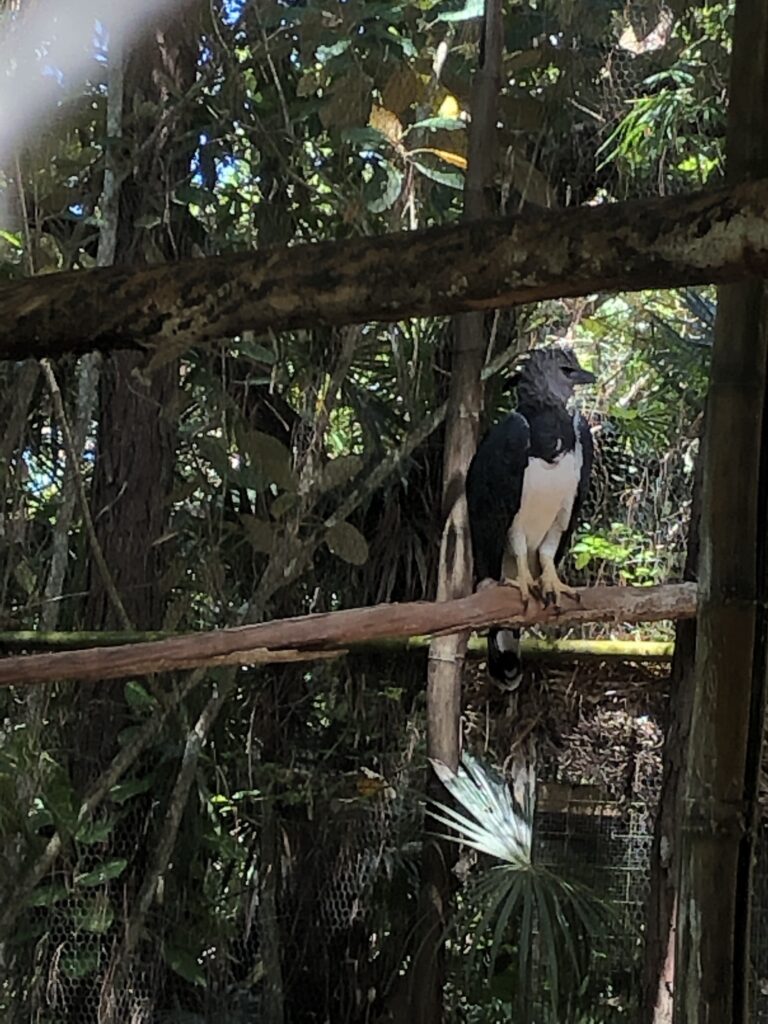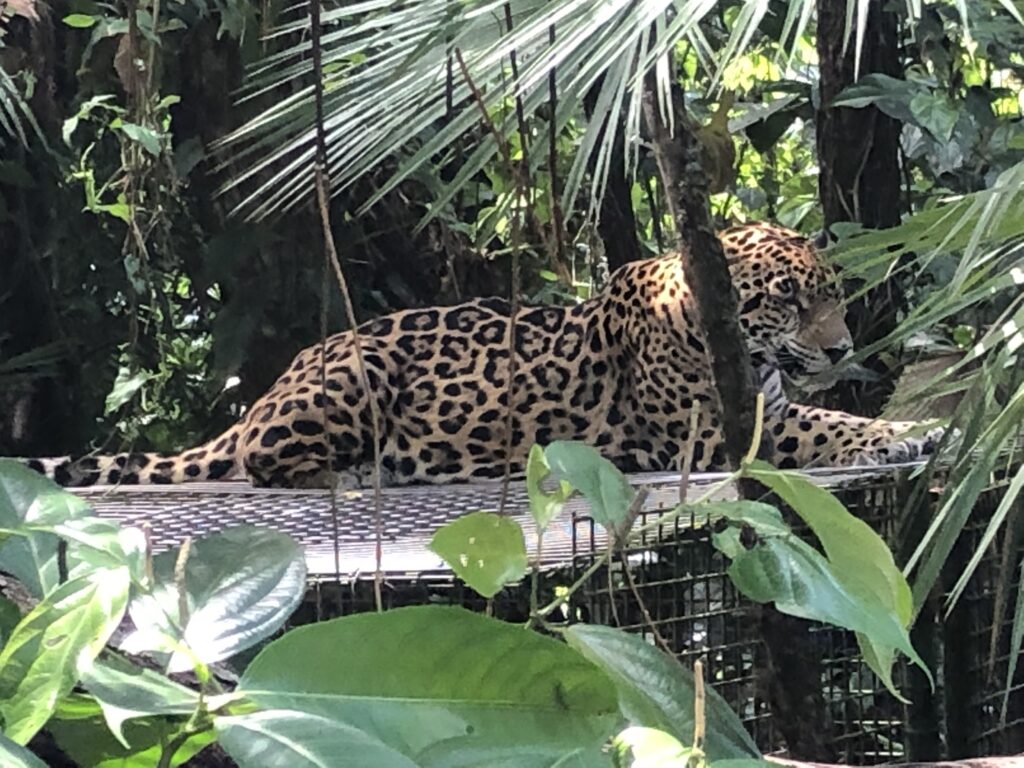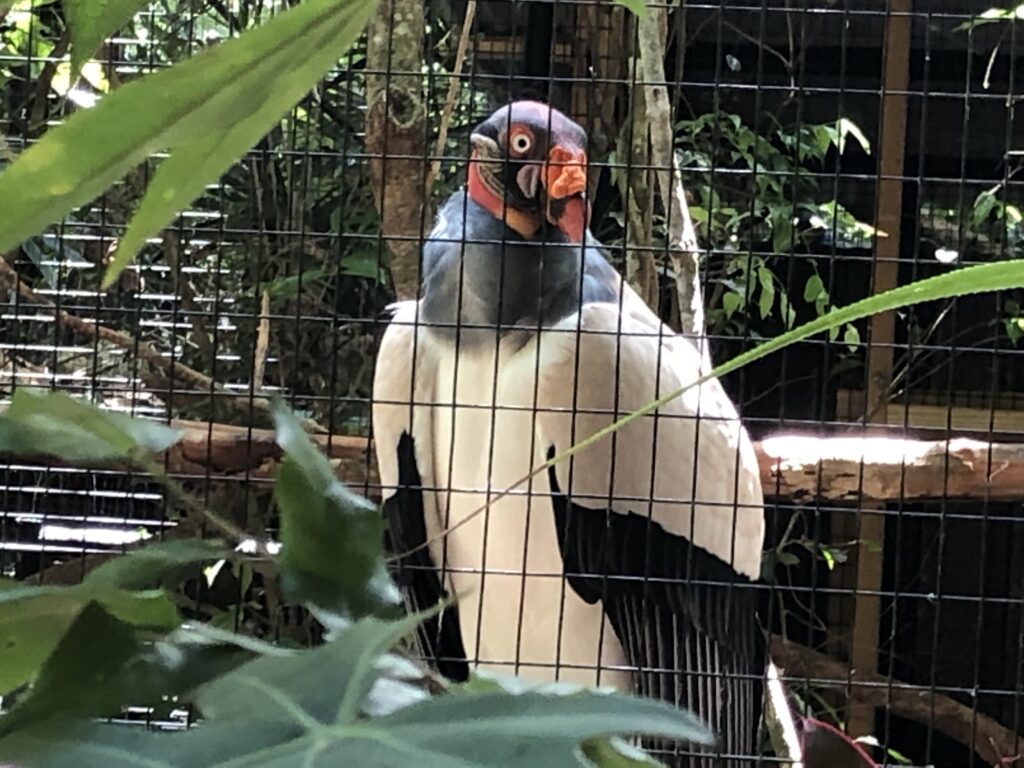I can’t quite get over the animals of Belize. They are so varied, so colorful, and so spectacular. It’s hard to know where to begin, so I’ll begin at the beginning.
If you visit Belize, go the Belize Zoo (https://www.belizezoo.org/). Let me say that again: You must visit the Belize Zoo if you are in the country. It is not large, but it has two of the most spectacular animals on the planet: Harpy’s eagles and jaguars. Add to that king vultures, toucans, ocelots, tapirs, howler monkeys, and a wide variety of hawks, other birds, and cats. The zoo is about 30 to 45 minutes away from the Belize City airport. It kind of feels like it’s out in the middle of no where, and it is. (Although less than five minutes away is a great restaurant called Cheers that has good food at good prices. Well worth the visit. http://www.cheersrestaurantbelize.com/)

Harpy’s Eagle 
Jaguar 
King Vulture
The zoo animals are mostly rescued or those raised in captivity who couldn’t survive without their human caretakers. Most of them have “written” corny poems that are on display throughout the zoo to explain their situations as well as why they are important to the Belizian ecosystem. The whole place is a fabulous learning experience for adults and children. Even on a hot, humid afternoon, the jungle canopy makes the visit doable. Grab a cold class of pineapple juice at the end of the trek, and all will be well.
So, that was the beginning. Today was the next phase, a boat trip up the Monkey River. There are dozens of guides in Placencia Village, but we liked one we came across during our ambles about town, Eagle Ray Tours (http://placenciatoursbz.weebly.com/), so that’s who we went with. We are glad we did. It was a small group, only four of us tourists with our boat captain, Candace, and our Monkey River native guide, Derwin.
We saw and heard but didn’t get good pictures or videos of — you guessed it — monkeys. They were cool — loud, swinging through the trees, eating leaves (65 percent of their diet is leaves, 35 percent fruits and flowers). We saw “Big Mike,” as the guides called him with his troop, and we found “Big Joe’s” troop, but not Big Joe. The mature howler males are the ones who make the noise.
We also learned a lot about the rain forest — different kinds of trees and vines (watch out for those spikes and thorns), blue crabs that run around the forest floor in a rain storm but otherwise live in holes that they’ve dug in the forest, velcro-y leaves (I still have one intentionally stuck to my t-shirt), vines that retain fresh water, and bamboo, which is not native to Belize but sure grows here like crazy.
As fun as the monkeys were, they were a small part of trip during a short hike in the rain forest. The real treat (for me!) was all of the birds. We saw a rare boat-billed heron, a juvenile (photo at the top of this blog) and an adult bare-throated tiger heron, a juvenile lesser blue heron (not to be confused with the common-in-America great blue heron, which we also saw several of), anhingas, cormorants, a common black hawk (saw one of those in Panama, too, some of you may remember), vultures, frigate birds, brown pelicans, a king fisher, many social fly catchers, and the spectacular Montezuma Oropendolas, with their bright yellow tails (that Montezuma reportedly put in his hair) and their huge woven nests, which they were tending. To top it off, we stopped near a small mangrove isle called Bird Island, where we watched a mama snowy egret feed two noisy babies while about half a dozen other egrets looked on. Just spectacular. I’d encourage you to check out these birds on Google images and hope that someday I’ll have a camera that’s good enough to capture a photo or two.
We also saw two different kinds of bats, one little tiny bat sleeping under the leaves of a palm, and about seven insect bats, the second smallest bat species, hanging out on on a log in the river. They blended in so well with the bark that we almost didn’t see them, and had I seen them without our guide, I would have thought they were frogs. Bats are incredibly important to the tropical ecosystem. We saw a beautiful flowering bush along the river with both bright yellow and bright red flowers, The bats pollinate the yellow ones, and they turn red overnight once they’ve been pollinated. How cool is that?
Lunch was in the village of Monkey River, a town of about 250 that used to be a town of nearly 3,000. Until the 1940s, the Monkey River was used for transporting bananas out of Belize. But a blight in late 40s moved the banana plantations farther inland, and then roads were used rather than the river, and the town has been in slow decline ever since. It’s a quaint spot, surrounded by mangrove forests. The place we ate was called Alice’s Restaurant, and, just like in the song, you could get anything you want (as long as it was chicken or fish with beans and rice).
Leaving the delta of the Monkey River and Caribbean Sea, we headed into more mangrove forests and came across a couple of herds of manatee. A research organization doing recent work on Belize manatees had put a little tail collar on one. We watched it swim and surface with its buddies for quite some time, following the little radio buoy around the lagoon. The water was a murky, but it was fun to watch their little noses come up to the surface for air and then follow their big, sea cow bodies as long as we could see them.
Overall, it was a great trip and has led us to an even greater appreciation of the big wide world we are exploring. After all, Belize has about 600 species of birds. We’ve seen a tenth of them, so there’s much more work to be done!
Really enjoyed all the photos in your gallery. Keep it up!
Thanks! This is fun, when I find the time to keep up — and as I figure out how all the technology works!